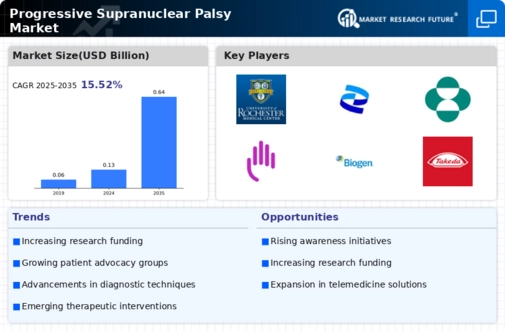Market Growth Projections
The Global Progressive Supranuclear Palsy Market Industry is projected to experience substantial growth over the coming years. With a market value of 0.13 USD Billion in 2024, it is expected to reach 0.64 USD Billion by 2035, reflecting a robust compound annual growth rate (CAGR) of 15.52% from 2025 to 2035. This growth is driven by various factors, including increasing prevalence, advancements in diagnostics, and emerging therapeutic options. The market dynamics indicate a promising future for stakeholders involved in the Global Progressive Supranuclear Palsy Market Industry, as the demand for effective treatments and improved patient care continues to rise.
Emerging Therapeutic Options
The emergence of new therapeutic options is significantly influencing the Global Progressive Supranuclear Palsy Market Industry. As research progresses, innovative treatments are being developed that target the underlying mechanisms of the disease. These emerging therapies offer hope for improved patient management and quality of life. The introduction of such options is likely to attract investment and interest from both healthcare providers and patients. As the market evolves, these new therapies may reshape treatment paradigms, contributing to the anticipated growth trajectory of the market. The potential for these advancements underscores the dynamic nature of the Global Progressive Supranuclear Palsy Market Industry.
Advancements in Diagnostic Techniques
The Global Progressive Supranuclear Palsy Market Industry benefits significantly from advancements in diagnostic techniques. Improved imaging technologies and biomarker identification have led to earlier and more accurate diagnoses of Progressive Supranuclear Palsy. This not only enhances patient outcomes but also increases the demand for targeted therapies. As healthcare providers adopt these advanced diagnostic tools, the market is likely to expand. The integration of innovative diagnostic methods is expected to contribute to the overall growth of the market, aligning with the projected CAGR of 15.52% from 2025 to 2035, as more patients are identified and treated.
Rising Awareness and Education Initiatives
Rising awareness and education initiatives play a crucial role in shaping the Global Progressive Supranuclear Palsy Market Industry. Various organizations and healthcare providers are actively working to educate the public and medical professionals about the symptoms and implications of Progressive Supranuclear Palsy. Increased awareness leads to earlier diagnosis and treatment, which can improve patient outcomes. This heightened focus on education is likely to drive market growth as more individuals seek medical advice and intervention. The ongoing efforts to disseminate information about this condition are expected to have a lasting impact on the Global Progressive Supranuclear Palsy Market Industry.
Growing Investment in Research and Development
Investment in research and development is a pivotal driver for the Global Progressive Supranuclear Palsy Market Industry. Pharmaceutical companies and research institutions are increasingly focusing on developing novel therapies and treatment modalities for this challenging condition. This surge in R&D funding is indicative of the potential for breakthroughs in treatment options, which could significantly alter the market landscape. As new therapies emerge, they are likely to attract more attention from healthcare providers and patients alike, further stimulating market growth. The ongoing commitment to R&D is essential for addressing the unmet needs within the Global Progressive Supranuclear Palsy Market Industry.
Increasing Prevalence of Progressive Supranuclear Palsy
The Global Progressive Supranuclear Palsy Market Industry is witnessing a notable rise in prevalence rates, which is a critical driver for market growth. As awareness of this neurodegenerative disorder increases, more cases are being diagnosed. In 2024, the market is valued at approximately 0.13 USD Billion, reflecting the growing recognition of Progressive Supranuclear Palsy. This increase in diagnosed cases is expected to continue, leading to a projected market value of 0.64 USD Billion by 2035. The rising number of patients necessitates enhanced treatment options and healthcare resources, thereby propelling the Global Progressive Supranuclear Palsy Market Industry forward.

























